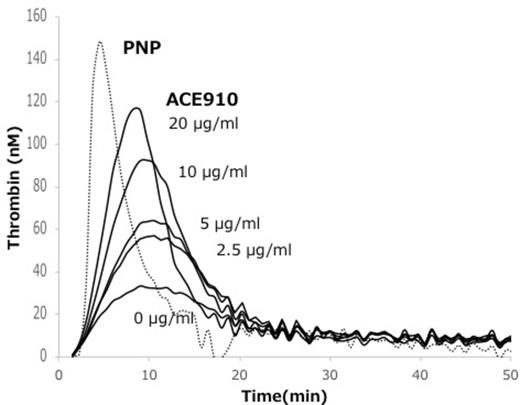Abstract
<Introduction> Acquired hemophilia A (AHA) is a rare bleeding disorder in which autoantibodies (autoAbs) against coagulation factor (F)VIII impair the coagulation system. Anti-FVIII autoAbs developed in AHA are polyclonal and the majority of these autoAbs bind to the A2, A3, and/or C2 domains in FVIII. Different inhibitory actions of anti-FVIII autoAbs, depending on their epitopes, are well-known. We have recently developed a humanized anti-FIXa/X bispecific antibody, ACE910, which mimics the cofactor function of FVIIIa even in the presence of anti-FVIII alloantibodies.
<Aim> In this study, we examined whether ACE910 improved the lower coagulation function in AHA patients using the comprehensive coagulation assays.
<Methods> Two representative experiments were performed as follows; 1) In vitro effects of ACE910 on normal pooled plasmas (PNPs) mixed with various anti-FVIII monoclonal Abs (mAbs) as the reconstituted AHA-models. For this experiments, several anti-FVIII mAbs; VIII-9222 (epitope: anti-a1), VIII-2236 (anti-A2), VIII-3776 (anti-A3C1), ESH4 (anti-C2) were prepared. 2) Ex vivo effects of ACE910 on plasmas obtained from nine patients with AHA, whose regions of Abs were A1, A2 and light chain for four patients, A2 and light chain for three patients, A2 for one patient and light chain for one patient. The coagulation functions in obtained samples were evaluated using the comprehensive coagulation assays, clot waveform analysis (CWA) and thrombin generation assays (TGA). In CWA, the minimum value of the first derivative (min1) and the second derivative (min2) were calculated as an index of the maximum acceleration of the reaction and the maximum velocity of coagulation, respectively. In TGA, calibrated automated thrombin generation assays derived the standard parameters; peak thrombin, lagtime, and time to peak. Total thrombin generation at intervals from the beginning to peak level was quantified. These values (nmol/l) were divided by the sample times (min, time to peak - lagtime), and represented the mean velocity of thrombin generation until the reach to peak level, expressed as mean velocity to peak thrombin (MV-peak thrombin). We defined the attenuation of inhibitory effect (% of AIE) represented that ACE910 attenuated the parameters inhibited by mAbs in artificial AHA or by allo-Abs in AHA patients, respectively. Figure 1 represents the % of AIE on thrombin peak in TGA.
<Results> PNPs were incubated with various anti-FVIII mAbs (100-500 mcg/ml) at 37 degrees Celsius for 2 hrs, and FVIII activities in these samples were decreased to 2.0-43%. These reactant mixtures were reacted with ACE910 (0-20 mcg/ml) for a further 2 hr-incubation. ACE910 improved the parameters of CWA (|min1|; 40-62%, and |min2|; 49-74% of AIE) and of TGA (thrombin peak; 46-72%, and MV-peak thrombin; 51-70% of AIE, respectively) in all PNPs with mAbs. These data indicated that ACE910 improved the coagulant activity in AHA patients. Therefore, we determined the efficacy of ACE910 for nine AHA patients ex vivo. FVIII activities and FVIII inhibitors were <1.0-7.5 % and 2.2-134 BU/ml, respectively. ACE910 improved the parameters for eight AHA patients in CWA (|min1|; 36-100 %, and |min2|; 52-100 % of AIE, respectively). For one AHA patient whose epitope was A2 and light chain, ACE910 showed the slight improvement in |min1| (12 % of AIE) and in |min2| (31 % of AIE). The reason was that the range of concentration of ACE910 was only from 0 to 5 mcg/dl. On the other hand, ACE910 improved the parameters for all AHA patients in TGA. ACE910 showed effect on thrombin peak (27-77 % of AIE). Furthermore, ACE910 improved MV-peak thrombin (17-73 % of AIE). Figure 2 shows representative TGA curve for the effect of ACE910 on one AHA patient whose allo-Ab was anti-light chain.
<Conclusion> Our results indicated that ACE910 could improve the coagulant activities in AHA patients independent of the regions of antibodies and might be useful for the treatment of AHA patients.
Takeyama:Chugai Pharmaceutical Co., Ltd.: Research Funding. Nogami:Bayer, NovoNordisk, Baxalta, Chugai, Kaketsuken, Pfizer, Biogen: Honoraria; Chugai: Membership on an entity's Board of Directors or advisory committees; Bayer, Novo Nordisk, Baxalta. Biogen: Research Funding. Matsumoto:Chugai Pharmaceutical Co., Ltd: Research Funding. Kitazawa:Chugai Pharmaceutical Co., Ltd: Employment, Equity Ownership, Patents & Royalties. Hattori:Chugai Pharmaceutical Co., Ltd: Employment, Equity Ownership, Patents & Royalties. Shima:Chugai Pharmaceutical Co., Ltd. and F. Hoffmann-La Roche Ltd.: Consultancy, Honoraria, Membership on an entity's Board of Directors or advisory committees, Research Funding.
Author notes
Asterisk with author names denotes non-ASH members.



This feature is available to Subscribers Only
Sign In or Create an Account Close Modal